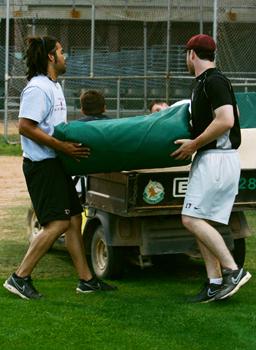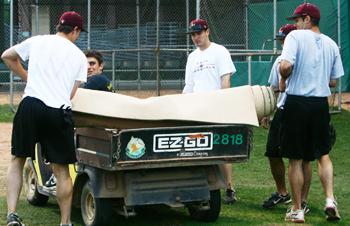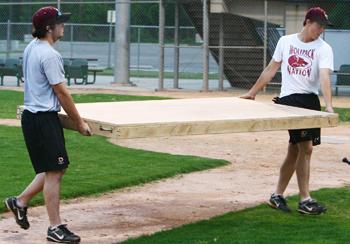Grounds maintenance for a baseball field provides more than just aesthetic appeal to the spectators.
Everything from the length of the grass to the height of the mound can affect the overall playability of a field and potentially the outcome of the game. But the Loyola men’s team has a direct hand in how Segnette Field plays – they themselves are the grounds crew.
Many small to mid-level college teams take part in the upkeep of their own fields, and for the ‘Pack it’s no different.
At every practice, Loyola players grab a rake or lawnmower before their gloves to assist in the continual maintenance that the field requires. The team comes out hours before home games to ensure the field is dry and ready for play.
“The one thing people don’t understand about a baseball field is that it’s a living, growing creature,” Head coach Gerald Cassard said. “Keeping up a baseball field is a full-time job.”
In early fall, the team spends two to three days getting the field ready for the season. This involves cutting out the shape of the infield grass, building up the pitcher’s mound and scavenging the entire field for weeds and misplaced grass on the outfield track. Each player has an assigned duty throughout the season to keep the field in playing shape for practice and games.
“Sometimes we come out just to work on the field, so we can come back to play the next day,” infielder Stephen Carroll, sociology senior, said.
The field’s upkeep consistently demands raking the baselines, mowing the grass and leveling the dirt. On game days the players are also responsible for painting the lines, painting the bases and conditioning the dirt to proper consistency.
Home field advantage means more to a baseball team than a favorable crowd. Teams have the opportunity to groom and shape the field to emphasize strengths or downplay weakness.
To compensate for pitching depth, Cassard keeps the infield grass around one and three quarter inches – almost an inch above Major League Baseball standards – to give his infield defense a quicker jump on the ball. “You can actually slow a ball down or speed it up by the height of the grass,” he said.
Brian Mason, accounting senior, pointed to the broadened semicircle in the grass around third base. This allows the third baseman to read a bounced throw easier off the dirt than the grass.
Weather can be an unkindly foe in the process. Cassard watches for rain in the forecast so the team can stretch tarps, which are weighed down by sandbags, across the infield. After a rain they use a manual electric pump to drain the puddles from the tarps.
Last January, after a severe storm soaked the field underneath the tarps, players arrived at Segnette that morning to drain the giant puddles in 38-degree weather with paper cups. Since they were unable to use a pump, the process lasted the entire day, pushing back the scheduled game against LSU-Shreveport to late in the evening.
Loyola is the only permanent home team of Segnette Field, although New Orleans high school teams often use it. ‘Pack players said other teams neglect maintenance duties on the field, leaving the responsibility for them.
“Pretty much (the maintenance) we would have to do after one of our games, we have to do after one of theirs,” said pitcher Paul Neill, who shares mound maintenance duties with fellow teammate Chucky Benach, English literature junior.
Few sports demand continuous upkeep of facilities like baseball, but the ‘Pack stays on top of the task.
“Everybody’s got a job and if everyone does it the way they’re supposed to then the field looks pretty good,” Borges said. “For us not having a field crew I’d say this field is in excellent shape.”
Steve Heath can be reached at [email protected].

(Dan Helfers)

The baseball team rolls up a hitting mat and puts it into a motorized cart. It’s one of the many steps they have to take to maintain their field. (Dan Helfers)







